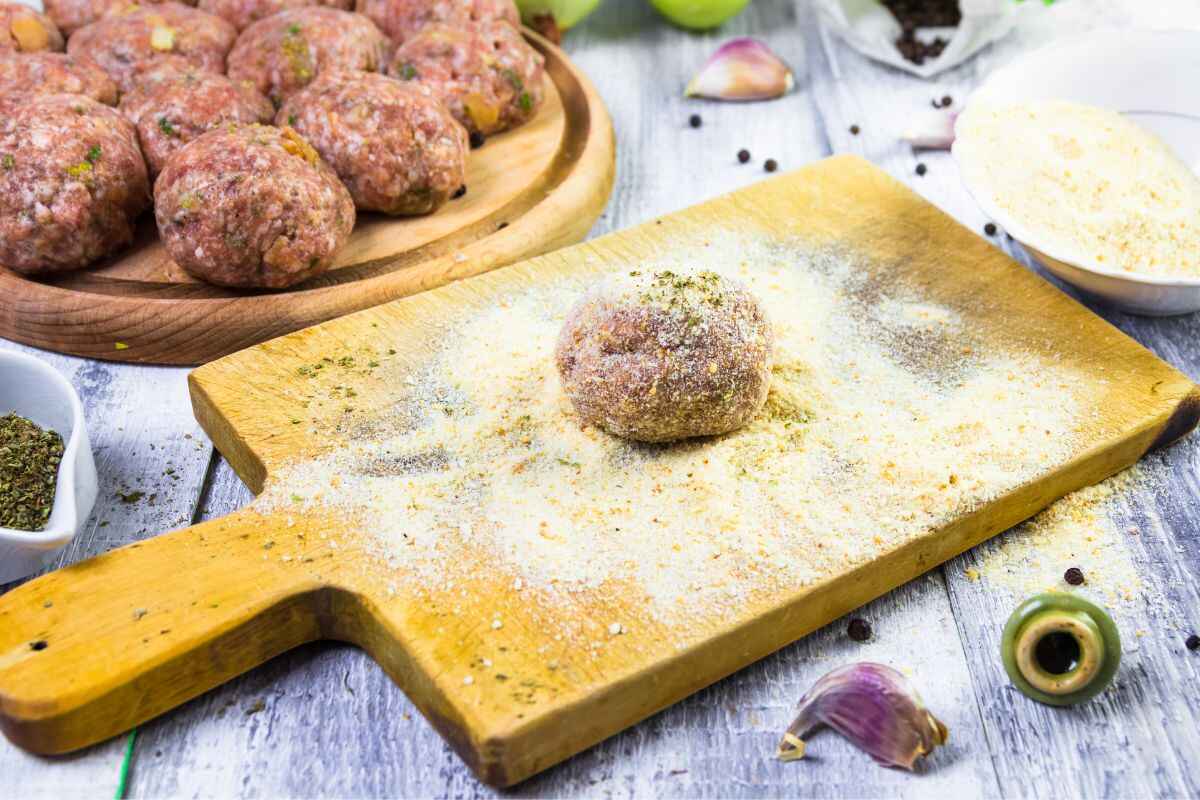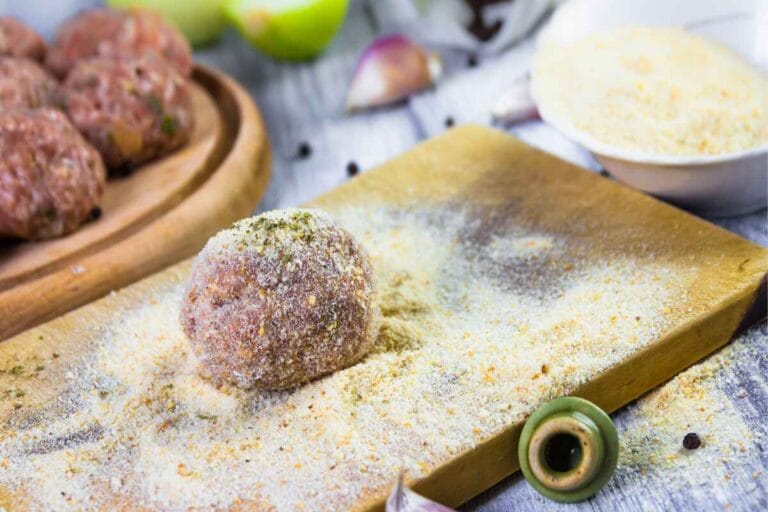Making a meatball recipe without breadcrumbs is easier than you might think! Whether you’re looking for a gluten-free option, following a keto diet, or just trying something new, you can still create juicy, flavorful meatballs without using traditional breadcrumbs. By swapping them out for creative alternatives, you’ll discover that your meatballs can be just as tender and delicious as ever—maybe even better! Let’s explore how to make this tasty twist on a classic dish.
Table of Contents
Why Choose a Meatball Recipe Without Breadcrumbs?
Skipping breadcrumbs isn’t just about following a special diet—though that’s definitely a great reason. In fact, there are so many other benefits worth considering. For one, leaving out breadcrumbs lets the meat truly stand out. This means better flavor, a smoother texture, and a more satisfying bite overall. On top of that, ditching breadcrumbs gives you the chance to try new ingredients, making your recipe both healthier and more flexible. What’s more, it ensures your dish works for all kinds of diets, like gluten-free or keto, without losing any of the taste or appeal.
Health Benefits of Breadcrumb-Free Meatballs
Going without breadcrumbs can really cut down on carbs, which makes these meatballs a great choice for anyone following a low-carb or keto diet. Plus, this option is perfect for those who need to avoid gluten. Even better, gluten-free eaters can enjoy these meatballs without having to worry about hidden gluten sneaking into the recipe.
“Breadcrumb-free doesn’t mean flavor-free; it’s actually the opposite! The right substitutes can add more richness to the mix.”
Perfect for Special Diets
Whether you’re cooking for someone with dietary restrictions or just experimenting, breadcrumb-free meatballs fit seamlessly into paleo, keto, gluten-free, or whole-food diets. They’re as versatile as they are inclusive.
Key Ingredients for Juicy Meatballs Without Breadcrumbs
Every great recipe starts with choosing the right ingredients. When you’re ditching breadcrumbs, the rest of the lineup becomes even more important. Here’s what you need to know:
Choosing the Right Meat
The type of meat you choose makes a big difference in both flavor and texture. If you want bold flavors, beef is a great option. If you prefer something lighter, turkey works well. Mixing pork and beef often gives you juicy and well-balanced meatballs. The most important thing, however, is to have enough fat in the meat. Lean cuts can dry out quickly, especially without breadcrumbs to help hold in the moisture.
Alternative Binders for Breadcrumb-Free Meatballs
Without breadcrumbs, you need a substitute that can hold your meatballs together without compromising flavor. Here are some top contenders:
- Almond flour: A keto favorite, this gives a subtle nutty flavor without being overpowering.
- Rolled oats: A heartier option that adds texture and fiber.
- Cheese: Parmesan or ricotta can act as both a binder and flavor booster. Who doesn’t love cheesy meatballs?
- Mashed vegetables: Think grated zucchini or mashed potatoes. They add moisture and keep things tender.
Adding Vegetables for Texture and Moisture
Don’t overlook how veggies can make your meatballs even better! Finely chopped onions, shredded carrots, or spinach can add moisture and keep them juicy. Plus, it’s an easy way to pack in extra nutrients without anyone noticing.
Preparing Your Ingredients for Maximum Flavor
Before diving in, spend some time prepping your ingredients. The finer your veggies are chopped, the better they’ll integrate into the mix. Use a food processor for consistent results. And when it comes to spices? Don’t hold back! Salt, pepper, garlic powder, and herbs like parsley or oregano can take your meatballs to the next level.
“Pro tip: Toast your spices lightly before adding them. This enhances their flavor and gives your meatballs a more robust taste.”
Step-by-Step Guide to Making Meatballs Without Breadcrumbs
Making breadcrumb-free meatballs is simple when you break it down into manageable steps. Let’s roll (pun intended):
- Combine Your Ingredients
In a large bowl, mix your meat of choice with your binder substitute, finely chopped veggies, egg, and spices. Use your hands—it’s messy but totally worth it. The key here is to mix gently. Overmixing can make your meatballs tough. - Shape Your Meatballs
Scoop out equal portions using a spoon or cookie scoop for consistency. Roll them lightly in your hands to form round balls. Keeping them uniform in size ensures they cook evenly. - Choose Your Cooking Method
Decide whether you want to fry, bake, or simmer your meatballs in sauce. Pan-frying gives a crisp exterior, while baking is healthier and more hands-off. Simmering in sauce is perfect for tender, melt-in-your-mouth results.
Tips for Cooking Meatballs Without Falling Apart
Worried about your meatballs disintegrating? It’s a common concern, but easily fixable:
- Make sure the meat mix isn’t too wet. Add more binder if needed.
- Let your meatballs chill in the fridge for 15–20 minutes before cooking. This firms them up.
- Avoid poking or moving them too much during cooking. Let them form a crust before flipping.

Best Substitutes for Breadcrumbs in Meatballs
One of the most exciting parts of going breadcrumb free is experimenting with substitutes. Different binders add unique textures and flavors, so feel free to get creative:
Almond Flour
Perfect for low-carb diets, almond flour is a great way to bind meatballs without adding carbs. It absorbs moisture beautifully, keeping the meatballs tender.
Rolled Oats
This classic substitute provides structure and is ideal for those who don’t mind a bit of texture in their meatballs. Just make sure to use gluten-free oats if needed.
Cheese
Cheese lovers rejoice! Adding parmesan or ricotta not only binds your meatballs but also infuses them with rich, creamy flavors. It’s like adding a surprise in every bite.
Cooking Methods for a Perfect Meatball Recipe Without Breadcrumbs
Now that you’ve prepped your meatballs, it’s time to cook them to perfection. Whether you prefer a crispy exterior or meatballs that melt in your mouth, there’s a cooking method for everyone. Let’s explore your options!
Pan-Frying for a Crispy Exterior
Pan-frying is a classic method for those who crave a crunchy, golden crust on their meatballs. The trick here is to use just enough oil to coat the pan and prevent sticking. Heat the oil over medium-high heat, then carefully place your meatballs in the pan.
Tips for Success:
- Don’t overcrowd the pan. This lowers the heat and results in uneven cooking.
- Let the meatballs sit undisturbed for a few minutes before turning them. This helps them develop a firm crust.
“If you want that irresistible crispy bite, pan-frying is your best friend. Just don’t rush the process!”
The downside to pan-frying? It can be a bit messy with oil splatters. But the flavor payoff is absolutely worth it.
Baking for Even Cooking and Less Oil
Baking meatballs is not only a healthier choice but also a more hands-off option, making it perfect for anyone who wants to skip the frying process. To get started, simply preheat your oven to 400°F (200°C). Next, line a baking sheet with parchment paper to prevent sticking and make cleanup easier. Once that’s done, carefully arrange your meatballs, making sure to space them evenly apart so they cook thoroughly and don’t touch. This method allows you to focus on other parts of your meal while the oven does the work for you!
Why Baking Works Well Without Breadcrumbs:
The even heat of the oven helps the meatballs cook uniformly. Since breadcrumbs often act as a moisture buffer, baking ensures your alternative binders have the time to work their magic without drying out the meatballs.
Pro Tip:
Flip the meatballs halfway through baking for a nicely browned exterior.
Simmering Gluten-Free Meatballs in Sauce
Want ultra-tender meatballs that practically melt in your mouth? Simmering them in sauce is the way to go. This method not only keeps the meatballs moist but also infuses them with the flavors of the sauce.
Here’s how to do it:
- First, lightly brown the meatballs in a pan (either by frying or baking).
- Then, transfer them to a pot of simmering sauce. Let them cook gently for 20–30 minutes, ensuring they absorb all the goodness of the sauce.
This method is especially great for breadcrumb-free recipes because the sauce adds back any lost moisture, keeping the meatballs juicy.
Common Problems and How to Fix Them
Cooking without breadcrumbs might feel like a challenge at first, but don’t let a few hiccups discourage you. Here are some common issues and foolproof solutions to keep your meatballs on point.
Meatballs Falling Apart
One of the most common concerns is that meatballs might crumble without breadcrumbs. This usually happens because the binder wasn’t strong enough or the meatball mixture was too dry.
Solutions:
- Add more of your chosen binder (e.g., almond flour or cheese). Start with a small amount and adjust as needed.
- Chill the meatballs before cooking. This helps firm up the mixture and prevents breakage.
How to Prevent Dryness in Breadcrumb-Free Meatballs
Breadcrumbs often act like a sponge, soaking up and holding onto moisture in your meatballs. However, when you skip them, dryness can sneak in if you’re not careful or if you skip a few key steps. This is why it’s so important to use ingredients that add extra moisture or choose cooking methods that keep everything juicy. With the right tricks, you won’t even miss the breadcrumbs!
Fixes:
- Use fattier cuts of meat. Lean meat tends to dry out faster.
- Incorporate moisture-rich ingredients like grated onions or zucchini.
- Simmer the meatballs in sauce instead of cooking them dry.
Balancing Flavors Without Overwhelming the Meat
When you’re not using breadcrumbs, the flavors of the meat and other ingredients are more pronounced. This can be a double-edged sword if the seasoning isn’t just right.
Tips:
- Taste the meat mixture before cooking (a small portion can be fried as a test).
- Use a mix of fresh herbs and dried spices for depth and balance.
- Don’t shy away from salt—it enhances the natural flavors of the meat.
“Cooking is like art; it’s all about balance. A pinch of this, a dash of that, and you’ll have perfectly seasoned meatballs!”
How to Pair Breadcrumb-Free Meatballs with Sauces and Sides
Meatballs are a versatile dish, but pairing them with the right sauces and sides can elevate your meal to a whole new level. Let’s explore some mouthwatering combinations.
Sauces That Enhance the Natural Flavor
The sauce you choose can make or break your meatball dish. Here are some tried-and-true options:
- Marinara Sauce: A classic choice, perfect for traditional Italian vibes.
- Creamy Alfredo Sauce: For a rich, indulgent twist.
- Spicy Tomato Sauce: Add a kick with chili flakes or harissa.
- Gravy: A comforting option, especially for pork or turkey meatballs.
Creative Side Dishes for a Complete Meal
While pasta is a classic pairing for meatballs, there’s a world of possibilities to explore:
- Zucchini Noodles (Zoodles): A low-carb alternative to pasta.
- Mashed Cauliflower: Creamy and satisfying without the carbs.
- Garlic Bread: Who doesn’t love soaking up sauce with warm, buttery bread?
- Roasted Veggies: A healthy, colorful side that complements the richness of meatballs.
Storing and Reheating Meatballs Without Breadcrumbs
If you’ve made a big batch of tasty meatballs, you might end up with leftovers—or perhaps you’re just planning ahead for a busy week. Either way, there’s no need to worry! With a few simple storage tricks and the right reheating methods, your breadcrumb-free meatballs can stay just as juicy and full of flavor for days, or even weeks. Plus, knowing how to store them properly makes it so much easier to enjoy a quick, delicious meal whenever you need it.
Tips for Freezing Meatballs
Freezing is an excellent way to extend the shelf life of your meatballs. Here’s how to do it like a pro:
- Cook First or Freeze Raw?
Both methods work, but pre-cooked meatballs are easier to reheat and can save time on busy nights. - Cool Before Freezing
If your meatballs are cooked, let them cool completely before freezing. This prevents condensation, which can lead to freezer burn. - Freeze Individually
Arrange the meatballs in a single layer on a baking sheet and freeze for 1–2 hours. Once frozen solid, transfer them to a resealable freezer bag or airtight container. This step ensures they don’t stick together. - Label and Date
Always label your freezer bags with the date to keep track of freshness. Meatballs can be frozen for up to three months.
How to Reheat Without Compromising Texture
Reheating meatballs without breadcrumbs can be tricky—they might dry out if not handled properly. But with the right method, they’ll be just as delicious as when they were freshly made.
In Sauce
The best way to reheat meatballs is to simmer them in a sauce. The liquid helps retain moisture, and the meatballs soak up even more flavor.
In the Oven
Preheat your oven to 350°F (175°C), place the meatballs in a baking dish, and cover with foil to prevent drying. Heat for about 20 minutes or until warmed through.
In the Microwave
If you’re in a hurry and need a quick solution, microwaving your meatballs is definitely an option. To keep them moist and prevent drying out, simply cover them with a damp paper towel. This will trap the steam as they heat up, helping to lock in the juices. For the best results, heat them in short 30-second intervals, checking in between to make sure they’re warming evenly. This way, you can avoid the risk of overcooking while still enjoying a hot, flavorful meal in no time.
“Remember: Reheating isn’t just about warming up—it’s about reviving that delicious, fresh-made taste.”

The Final Word on Making a Meatball Recipe Without Breadcrumbs
Making a meatball recipe without breadcrumbs is a great way to cater to various dietary needs while keeping things flavorful and juicy. Whether you’re avoiding gluten, cutting carbs, these breadcrumb-free meatballs deliver all the taste without the filler.
When preparing a meatball recipe without breadcrumbs, choosing the right ingredients and cooking techniques is key. Alternatives like almond flour or grated vegetables can help you create moist, delicious meatballs every time.
By mastering this approach, you don’t have to compromise on flavor or texture. This guide has shown you how to make a meatball recipe without breadcrumbs that’s perfect for any occasion—whether paired with marinara, roasted veggies, or enjoyed on its own.
Now it’s your turn to try it out and enjoy the delicious results. Who needs breadcrumbs when you have all this flavor?
FAQs About Meatball Recipe Without Breadcrumbs
Curious about making meatballs without breadcrumbs? Let’s tackle some of the most common questions to set you up for success.
What is the best binder for breadcrumb-free meatballs?
The best binder depends on your dietary preferences. Almond flour is perfect for keto diets, while rolled oats add a hearty texture. For a cheesy twist, try Parmesan or ricotta.
Can I make meatballs ahead of time?
Absolutely! You can prepare the mixture a day in advance and store it in the fridge. Alternatively, shape the meatballs and freeze them for cooking later.
How do I ensure the meatballs stay juicy?
Using a higher fat meat, incorporating moisture-rich ingredients like grated onions, and simmering the meatballs in sauce are all great ways to maintain juiciness.
What is the ideal meat ratio for breadcrumb-free meatballs?
A mix of ground beef and pork (80% lean, 20% fat) is ideal for flavor and texture. If you’re using leaner meats like turkey, be sure to add a binder and some fat, such as olive oil or cheese.
How do I prevent my meatballs from falling apart?
Chilling the mixture before shaping and cooking helps firm up the meatballs. Also, make sure you don’t overmix the ingredients—gentle handling is key.
Can I make breadcrumb-free meatballs vegetarian?
Yes! Replace the meat with plant-based proteins like lentils or chickpeas, and use mashed sweet potatoes or almond flour as a binder.
Conclusion: Mastering Meatball Recipes Without Breadcrumbs
Congratulations—you’re now equipped to create meatballs that are not only delicious but also free of breadcrumbs! Whether you’re catering to a gluten-free crowd, following a low-carb lifestyle, or simply trying something new, these tips and tricks have you covered.
Cooking without breadcrumbs opens up a world of flavor possibilities. It’s an opportunity to let the meat, herbs, and spices take center stage while experimenting with creative binders like almond flour, oats, or even cheese. From pan-frying for that golden crust to simmering in sauce for a melt-in-your-mouth experience, the options are endless.
So, roll up your sleeves, get your hands messy, and create a batch of unforgettable meatballs. After all, who needs breadcrumbs when you have this much flavor?
“Breadcrumbs are just one chapter in the meatball cookbook. Now, it’s your turn to write the rest of the story!”
🍴 Ready to cook? Let those breadcrumb-free meatballs steal the show at your next dinner!
For more information on gluten-free cooking and alternatives to breadcrumbs, consider exploring the following resources:
- Gluten-Free Cooking Tips: Healthline’s Gluten-Free Diet Guide offers comprehensive advice on adopting a gluten-free lifestyle, including foods to avoid and suitable substitutes.
- Juicy Meatball Recipe Tips: No Stop Recipes’ Guide on How to Make Juicy Meatballs offers additional techniques and ideas for creating flavorful, moist meatballs every time.
These articles and guides offer valuable insights to help you navigate gluten-free cooking and find the best breadcrumb alternatives for your culinary creations.

